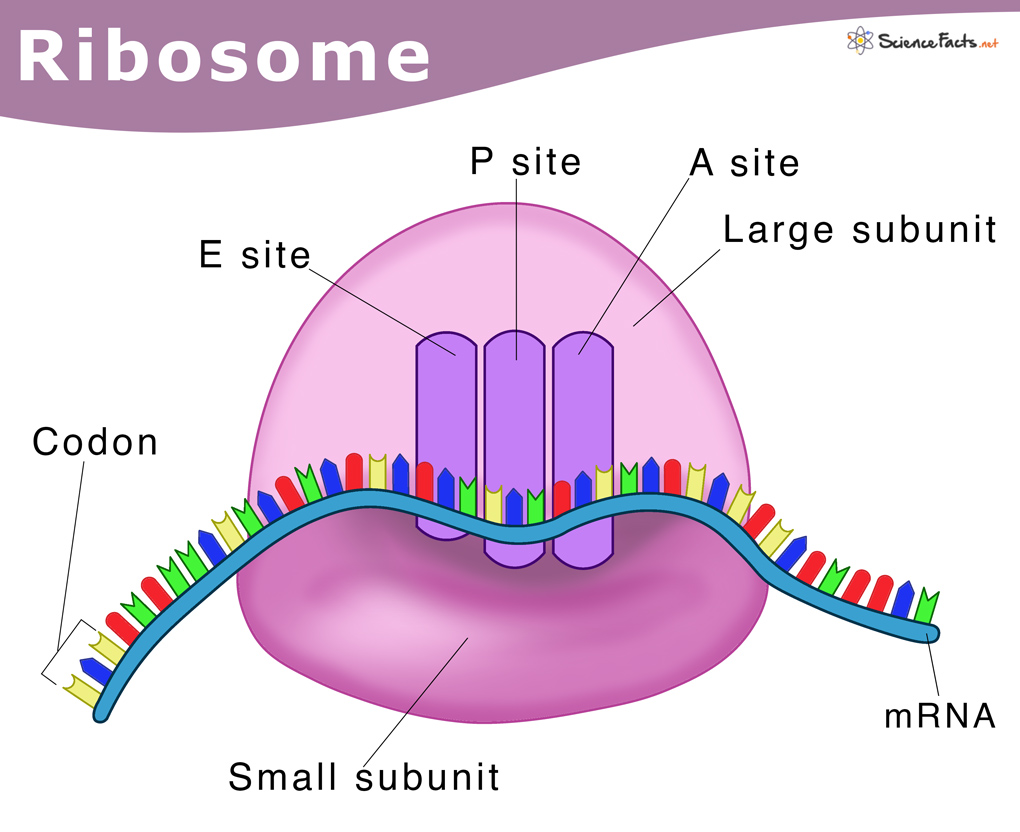Ribosomes: Definition, Structure, and Functions
What are Ribosomes
Ribosomes are cell structures present in large numbers in all living cells acting as the site of protein synthesis. In prokaryotes, they float freely in the cytoplasm, while in eukaryotes they are free or remain bound to the outer membrane of the endoplasmic reticulum. They are also found in the mitochondria and chloroplast of a eukaryotic cell.
Location
Their location in a cell determines what kind of proteins it makes up. The ribosomes are either found to exist in the free-floating form throughout the cell cytosol or remain attached to the endoplasmic reticulum. The proteins synthesized from the free ribosomes are utilized within the cell, while those fixed to the outer surface of endoplasmic reticulum are mainly exported out. In an animal or human cell, numerous ribosomes remain attached to a single mRNA strand; this structure is called a polysome.
Where are Ribosomes Made
They are made and packaged in the nucleolus, a small dense region within the nucleus, by a process called ribosome biogenesis.
Abundance
The number of ribosomes in a cell depends on cellular activity. On average, in a mammalian cell, there can be about 10 million ribosomes. In the bacterium Escherichia coli, it accounts to almost 15,000, constituting as much as one-quarter of the cell’s total mass.
Structure and Characteristics
Structurally it looks like a little hamburger bun having two subunits: a big one (the top bun) and a small one (the bottom bun).
Size and Shape
They are remarkable for their uniformity in size and shape. Ribosomes found in higher plant and animal cells are oblate or spheroids in shape, having a diameter of 150 to 200 A0. The exact size of the ribosomes varies, depending on the cell type and whether the cell is resting or participating in cell division. Both free and the bound forms are not membrane-enclosed.
Parts and Their Composition: What are Ribosomes Made Of
They are organelles composed largely of specialized RNA, known as ribosomal RNA (rRNA) and dozens of distinct proteins and thus also known as ribonucleoproteins. Around 37 to 62% of the ribosome is comprised of RNA, and the rest are proteins.
When viewed under the electron microscope, ribosomal proteins and rRNAs are arranged into two distinct ribosomal pieces of different sizes, known generally as the large and small subunit of the ribosome. Both the subunits combine to form a complete organelle. The two subunits are classified based on their sedimentation constant, measured in Svedberg unit (S). It offers is a measure of the sedimentation rate of a particle, based on its size, shape, and density.
Types
Based on the sedimentation constant of their subunits, ribosomes are broadly classified into two types:
- Prokaryotic (Bacterial) Ribosomes: Have a sedimentation constant of 70S (equal to the molecular weight of 2.7×106 Daltons) with the small subunit of 30S and large subunit of 50S. E. coli, for example, with a small 30S subunit has a 16S RNA subunit consisting of 1540 nucleotides bound to 21 proteins, while the large 50S subunit is composed of a 5S RNA subunit having 120 nucleotides, a 23S RNA subunit with 2900 nucleotides and 31 proteins.
- Eukaryotic Ribosomes: Have 80S ribosomes (equal to the molecular weight of 4×106 Daltons) located in their cytosol, each consisting of a small 40S and large 60S subunit. Humans, for example, with a small 40S subunit has a 18S RNA having 1900 nucleotides and 33 proteins, while the large 60S subunit is composed of a 5S RNA with 120 nucleotides, 28S RNA with 4700 nucleotides, 5.8S RNA with 160 nucleotides and 46 proteins.
Functions: What Does the Ribosome Do
Also known as the protein manufacturing unit of the cell, the main function of the ribosome is that it acts as the site where amino acids are assembled to produce proteins. The process of protein synthesis is commonly known as translation.
The other important role of ribosomes, where it acts as a stimulator of intermediate chemical reactions of protein synthesis is described below:
- Assembling of ribosomal subunits
- Linking of amino acids in order as specified by another type of RNA molecule called messenger RNA (mRNA). mRNA is synthesized from DNA by a process called transcription
- Bringing together all the elements needed for protein synthesis
- Carrying out other intermediate chemical reactions such as peptidyl transfer, peptidyl hydrolysis, and ribosomal translocation during protein synthesis
Protein is necessary for almost every biological activity, including growth and metabolism, cell division, and repair, and thus, ribosomes are essential for the survival of living things. A cell without a ribosome would not be able to synthesize proteins and will subsequently die soon.
FAQs
Ans. Ribosomes were first observed in the mid-1950s by Romanian-American cell biologist George Emil Palade, using an electron microscope, as dense particles or granules. The term ‘ribosome’ was proposed by Richard B. Roberts and derived from the term ‘ribonucleic acid’ and the Latin word ‘som’ meaning ‘body’.
Ans. Viruses do not have ribosomes and hence cannot synthesize proteins necessary for its independent survival.
Ans. The chloroplast is the only plant cell organelle that contains its own DNA and ribosomes.
Ans. The process that immediately precedes protein synthesis is transcription. Transcription is the process of copying DNA to messenger RNA or mRNA.
Ans. Bound ribosomes synthesize proteins primarily for secretion, membrane fixation, or for use in lysosomes.
Ans. Transfer RNA or tRNA carries amino acids to the ribosome during protein synthesis.
Ans. The nucleolus within the nucleus synthesizes ribosome subunits, which are then assembled into a complete organelle. The nucleus then supplies mRNA to the ribosomes that help in protein synthesis.
Ans. Ribosomes get their instruction for protein assembly from messenger RNA. The mRNA is made of a sequence of RNA nucleotides derived from DNA (transcription) that contains information to form a protein (translation).
-
References
Article was last reviewed on Tuesday, August 24, 2021






